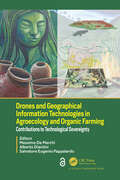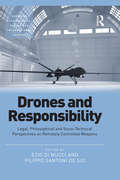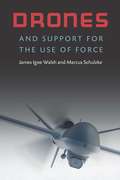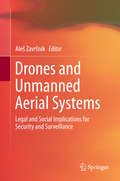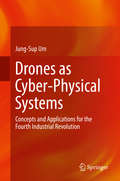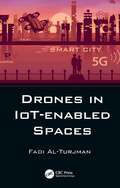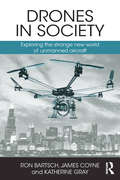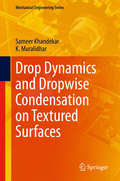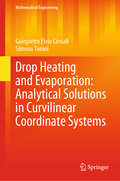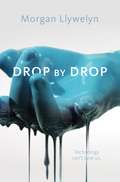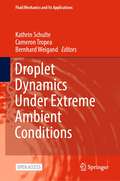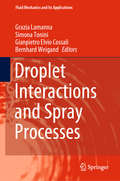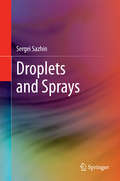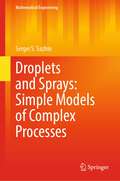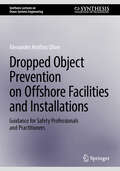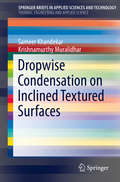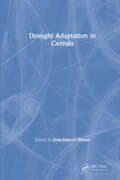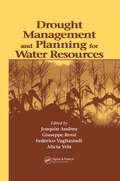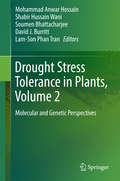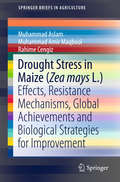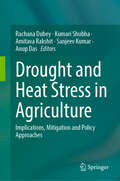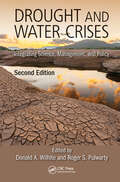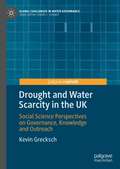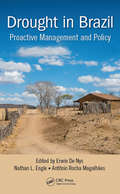- Table View
- List View
Drones and Geographical Information Technologies in Agroecology and Organic Farming: Contributions to Technological Sovereignty
by Massimo De MarchiAlthough organic farming and agroecology are normally not associated with the use of new technologies, it’s rapid growth, new technologies are being adopted to mitigate environmental impacts of intensive production implemented with external material and energy inputs. GPS, satellite images, GIS, drones, help conventional farming in precision supply of water, pesticides, fertilizers. Prescription maps define the right place and moment for interventions of machinery fleets. Yield goal remains the key objective, integrating a more efficient use or resources toward an economic-environmental sustainability. Technological smart farming allows extractive agriculture entering the sustainability era. Societies that practice agroecology through the development of human-environmental co-evolutionary systems represent a solid model of sustainability. These systems are characterized by high-quality agroecosystems and landscapes, social inclusion, and viable economies. This book explores the challenges posed by the new geographic information technologies in agroecology and organic farming. It discusses the differences among technology-laden conventional farming systems and the role of technologies in strengthening the potential of agroecology. The first part reviews the new tools offered by geographic information technologies to farmers and people. The second part provides case studies of most promising application of technologies in organic farming and agroecology: the diffusion of hyperspectral imagery, the role of positioning systems, the integration of drones with satellite imagery. The third part of the book, explores the role of agroecology using a multiscale approach from the farm to the landscape level. This section explores the potential of Geodesign in promoting alliances between farmers and people, and strengthening food networks, whether through proximity urban farming or asserting land rights in remote areas in the spirit of agroecological transition. The Open Access version of this book, available at www.taylorfrancis.com, has been made available under a Creative Commons 4.0 license.
Drones and Responsibility: Legal, Philosophical and Socio-Technical Perspectives on Remotely Controlled Weapons (Emerging Technologies, Ethics and International Affairs)
by Ezio Di Nucci Filippo Santoni SioHow does the use of military drones affect the legal, political, and moral responsibility of different actors involved in their deployment and design? This volume offers a fresh contribution to the ethics of drone warfare by providing, for the first time, a systematic interdisciplinary discussion of different responsibility issues raised by military drones. The book discusses four main sets of questions: First, from a legal point of view, we analyse the ways in which the use of drones makes the attribution of criminal responsibility to individuals for war crimes more complicated and what adjustments may be required in international criminal law and in military practices to avoid ’responsibility gaps’ in warfare. From a moral and political perspective, the volume looks at the conditions under which the use of military drones by states is impermissible, permissible, or even obligatory and what the responsibilities of a state in the use of drones towards both its citizens and potential targets are. From a socio-technical perspective, what kind of new human machine interaction might (and should) drones bring and which new kinds of shared agency and responsibility? Finally, we ask how the use of drones changes our conception of agency and responsibility. The book will be of interest to scholars and students in (military) ethics and to those in law, politics and the military involved in the design, deployment and evaluation of military drones.
Drones and Support for the Use of Force
by Marcus Schulzke James Igoe WalshCombat drones are transforming attitudes about the use of military force. Military casualties and the costs of conflict sap public support for war and for political and military leaders. Combat drones offer an unprecedented ability to reduce these costs by increasing accuracy, reducing the risks to civilians, and protecting military personnel from harm. These advantages should make drone strikes more popular than operations involving ground troops. Yet many critics believe drone warfare will make political leaders too willing to authorize wars, weakening constraints on the use of force. Because combat drones are relatively new, these arguments have been based on anecdotes, a handful of public opinion polls, or theoretical speculation. Drones and Support for the Use of Force uses experimental research to analyze the effects of combat drones on Americans’ support for the use of force. The authors’ findings—that drones have had important but nuanced effects on support for the use of force—have implications for democratic control of military action and civil-military relations and provide insight into how the proliferation of military technologies influences foreign policy.
Drones and Unmanned Aerial Systems
by Aleš ZavršnikThis book tackles the regulatory issues of Unmanned Aerial Systems (UAS) or Remotely-Piloted Aerial Systems (RPAS), which have profound consequences for privacy, security and other fundamental liberties. Collectively known as "drones," they were initially deployed for military purposes: reconnaissance, surveillance and extrajudicial executions. Today, we are witnessing a growth of their use into the civilian and humanitarian domain. They are increasingly used for goals as diverse as news gathering, aerial inspection of oil refinery flare stacks, mapping of the Amazonian rain-forest, crop spraying and search and rescue operations. The civil use of drones is becoming a reality in the European Union and in the US. The drone revolution may be a new technological revolution. Proliferation of the next generation of "recreational" drones show how drones will be sold as any other consumer item. The cultural perception of the technology is shifting, as drones are increasingly being used for humanitarian activities, on one hand, but they can also firmly be situated in the prevailing modes of postmodern governance on the other hand. This work will be of interest to researchers in Criminology and Criminal Justice interested in issues related to surveillance, security, privacy, and technology. It will also provide a criminological background for related legal issues, such as privacy law, aviation law, international criminal law, and comparative law.
Drones as Cyber-Physical Systems: Concepts And Applications For The 4th Industrial Revolution
by Jung-Sup UmThis book introduces the concept of using drones as a teaching tool to explore the fundamental principles, technology and applications of Cyber-Physical Systems (CPS). A short introduction sets CPS in the context of the 4th industrial revolution, and describes various CPS technologies including self-driving cars, commercial intelligent drones and mobile robots, in which artificial intelligence routinely supports smarter decision-making. The core of the book then focuses on commercially available drones, the only available system offering the advantage of cyber-physical bridging through 3D autonomous dynamic flying in classroom conditions. Chapters describe drone technology, including location sensors and imaging systems. CPS theory is explained through typical drone flying procedures and do-it-yourself (DIY) aerial photography in which communication between sensors, actuators and controllers occurs through cyber-physical bi-directional bridging. This book opens new possibilities in fostering 4th industrial revolution literacy, introducing relevant examples from readily available equipment, making core elements of cyber-physical bridging accessible. It is aimed primarily at those students who have an interest in CPS, drones and those from disciplines that are concerned with spatial information.
Drones in IoT-enabled Spaces
by Fadi Al-TurjmanThe Internet of Things (IoT) is a system of inter-connected devices, objects, and organisms. Among these devices, drones are gaining lots of interest. Drones are expected to communicate with cellular networks in the next generation networks (5G and beyond) which opens the door for another exciting research area. This book considers very important research areas in drone and cellular networks. It addresses major issues and challenges in drone-based solutions proposed for IoT-enabled cellular/computer networks, routing/communication protocols, surveillances applications, secured data management, and positioning approaches. It focuses mainly on smart and context-aware implementations.
Drones in Society: Exploring the strange new world of unmanned aircraft
by Ron Bartsch James Coyne Katherine GrayThe integration of drones into society has attracted unprecedented attention throughout the world. The change, for aviation, has been described as being equally as big as the arrival of the jet engine. This book examines the issues that surround this change, for our society and the legal frameworks that preserve our way of life. Drones in Society takes the uninitiated on a journey to understand the history of drones, the present day and the potential future in order to demystify the media hype. Written in an accessible style, Drones in Society will appeal to a broad range of interested readerships, among them students, safety regulators, government employees, airspace regulators, insurance brokers and underwriters, risk managers, lawyers, privacy groups and the Remotely Piloted Aircraft System (RPAS) industry generally. In a world first, this book is a light and interesting read; being both relatable and memorable while discussing complex matters of privacy, international law and the challenges ahead for us all.
Drop Dynamics and Dropwise Condensation on Textured Surfaces (Mechanical Engineering Series)
by Sameer Khandekar K. MuralidharThis book is an expanded form of the monograph, Dropwise Condensation on Inclined Textured Surfaces, Springer, 2013, published earlier by the authors, wherein a mathematical model for dropwise condensation of pure vapor over inclined textured surfaces was presented, followed by simulations and comparison with experiments. The model factored in several details of the overall quasi-cyclic process but approximated those at the scale of individual drops. In the last five years, drop level dynamics over hydrophobic surfaces have been extensively studied. These results can now be incorporated in the dropwise condensation model.Dropwise condensation is an efficient route to heat transfer and is often encountered in major power generation applications. Drops are also formed during condensation in distillation devices that work with diverse fluids ranging from water to liquid metals. Design of such equipment requires careful understanding of the condensation cycle, starting from the birth of nuclei, followed by molecular clusters, direct growth of droplets, their coalescence, all the way to instability and fall-off of condensed drops. The model described here considers these individual steps of the condensation cycle. Additional discussions include drop shape determination under static conditions, a fundamental study of drop spreading in sessile and pendant configurations, and the details of the drop coalescence phenomena. These are subsequently incorporated in the condensation model and their consequences are examined. As the mathematical model is spread over multiple scales of length and time, a parallelization approach to simulation is presented. Special topics include three-phase contact line modeling, surface preparation techniques, fundamentals of evaporation and evaporation rates of a single liquid drop, and measurement of heat transfer coefficient during large-scale condensation of water vapor. We hope that this significantly expanded text meets the expectations of design engineers, analysts, and researchers working in areas related to phase-change phenomena and heat transfer.
Drop Heating and Evaporation: Analytical Solutions in Curvilinear Coordinate Systems (Mathematical Engineering)
by Simona Tonini Gianpietro Elvio CossaliThis book describes analytical methods for modelling drop evaporation, providing the mathematical tools needed in order to generalise transport and constitutive equations and to find analytical solutions in curvilinear coordinate systems. Transport phenomena in gas mixtures are treated in considerable detail, and the basics of differential geometry are introduced in order to describe interface-related transport phenomena. One chapter is solely devoted to the description of sixteen different orthogonal curvilinear coordinate systems, reporting explicitly on the forms of their differential operators (gradient, divergent, curl, Laplacian) and transformation matrices. The book is intended to guide the reader from mathematics, to physical descriptions, and ultimately to engineering applications, in order to demonstrate the effectiveness of applied mathematics when properly adapted to the real world. Though the book primarily addresses the needs of engineering researchers, it will also benefit graduate students.
Drop by Drop: Book One Step By Step (Step by Step #1)
by Morgan LlywelynFrom Morgan Llywelyn, the bestselling author of Lion of Ireland and the Irish Century series, comes Drop By Drop her first near-future science fiction thrillerUnbound Worlds—The Best Sci Fi and Fantasy Books of June 2018 In this first book in the Step By Step trilogy, global catastrophe occurs as all plastic mysteriously liquefies. All the small components making many technologies possible—navigation systems, communications, medical equipment—fail. In Sycamore River, citizens find their lives disrupted as everything they've depended on melts around them, with sometimes fatal results. All they can rely upon is themselves.And this is only the beginning . . .At the Publisher's request, this title is being sold without Digital Rights Management Software (DRM) applied.
Droplet Dynamics Under Extreme Ambient Conditions (Fluid Mechanics and Its Applications #124)
by Cameron Tropea Bernhard Weigand Kathrin SchulteThis open access book presents the main results of the Collaborative Research Center SFB-TRR 75, which spanned the period from 2010 to 2022. Scientists from a variety of disciplines, ranging from thermodynamics, fluid mechanics, and electrical engineering to chemistry, mathematics, computer science, and visualization, worked together toward the overarching goal of SFB-TRR 75, to gain a deep physical understanding of fundamental droplet processes, especially those that occur under extreme ambient conditions. These are, for example, near critical thermodynamic conditions, processes at very low temperatures, under the influence of strong electric fields, or in situations with extreme gradients of boundary conditions. The fundamental understanding is a prerequisite for the prediction and optimisation of engineering systems with droplets and sprays, as well as for the prediction of droplet-related phenomena in nature. The book includes results from experimental investigations as well as new analytical and numerical descriptions on different spatial and temporal scales. The contents of the book have been organised according to methodological fundamentals, phenomena associated with free single drops, drop clusters and sprays, and drop and spray phenomena involving wall interactions.
Droplet Interactions and Spray Processes (Fluid Mechanics and Its Applications #121)
by Bernhard Weigand Grazia Lamanna Simona Tonini Gianpietro Elvio CossaliThis book provides a selection of contributions to the DIPSI workshop 2019 (Droplet Impact Phenomena & Spray Investigations) as well as recent progress of the Int. Research Training Group “DROPIT”.The DIPSI workshop, which is now at its thirteenth edition, represents an important opportunity to share recent knowledge on droplets and sprays in a variety of research fields and industrial applications. The research training group “DROPIT” is focused on droplet interaction technologies where microscopic effects influence strongly macroscopic behavior. This requires the inclusion of interface kinetics and/or a detailed analysis of surface microstructures. Normally, complicated technical processes cover the underlying basic mechanisms, and therefore, progress in the overall process modelling can hardly be gained. Therefore, DROPIT focuses on the underlying basic processes. This is done by investigating different spatial and/or temporal scales of the problems and by linking them through a multi-scale approach. In addition, multi-physics are required to understand e.g. problems for droplet-wall interactions, where porous structures are involved.
Droplets and Sprays
by Sergei SazhinProviding a clear and systematic description of droplets and spray dynamic models, this book maximises reader insight into the underlying physics of the processes involved, outlines the development of new physical and mathematical models and broadens understanding of interactions between the complex physical processes which take place in sprays. Complementing approaches based on the direct application of computational fluid dynamics (CFD), Droplets and Sprays treats both theoretical and practical aspects of internal combustion engine process such as the direct injection of liquid fuel, subcritical heating and evaporation. Including case studies that illustrate the approaches relevance to automotive applications, it is also anticipated that the described models can find use in other areas such as in medicine and environmental science.
Droplets and Sprays: Simple Models of Complex Processes (Mathematical Engineering)
by Sergei S. SazhinThis book acts as a guide to simple models that describe some of the complex fluid dynamics, heat/mass transfer and combustion processes in droplets and sprays. Attention is focused mainly on the use of classical hydrodynamics, and a combination of kinetic and hydrodynamic models, to analyse the heating and evaporation of mono- and multi-component droplets. The models were developed for cases when small and large numbers of components are present in droplets. Some of these models are used for the prediction of time to puffing/micro-explosion of composite water/fuel droplets — processes that are widely used in combustion devices to stimulate disintegration of relatively large droplets into smaller ones. The predictions of numerical codes based on these models are validated against experimental results where possible. In most of the models, droplets are assumed to be spherical; some preliminary results of the generalisation of these models to the case of non-spherical droplets, approximating them as spheroids, are presented.
Dropped Object Prevention on Offshore Facilities and Installations: Guidance for Safety Professionals and Practitioners (Synthesis Lectures on Ocean Systems Engineering)
by Alexander Arnfinn OlsenThe prevention of dropped objects is an important component of safeguarding personnel, property and the maritime environment. This concise book has been developed to provide safety professionals and practitioners with specific guidance and criteria on the development, implementation and management of dropped object prevention programs which corresponds to a growing industry-wide development to mitigate and eliminate the hazards imposed by dropped objects. This book relates to the Class requirements for an onboard dropped object prevention program to be implemented on offshore assets, and provides the design requirements for equipment primary securing, secondary retention methods and securing for specific equipment, etc. This book is intended for use by offshore installation Owners, Operators, and Companies whose intention is to prepare for, and ultimately apply for optional Class notations highlighting the installation’s compliance with dropped object safety management. For the benefit of context, the book uses the provisions which relate specifically to the DOPP and DOPP+ notations.
Dropwise Condensation on Textured Surfaces
by Krishnamurthy Muralidhar Sameer KhandekarDropwise Condensation on Textured Surfaces presents a holistic framework for understanding dropwise condensation through mathematical modeling and meaningful experiments. The book presents a review of the subject required to build up models as well as to design experiments. Emphasis is placed on the effect of physical and chemical texturing and their effect on the bulk transport phenomena. Application of the model to metal vapor condensation is of special interest. The unique behavior of liquid metals, with their low Prandtl number and high surface tension, is also discussed. The model predicts instantaneous drop size distribution for a given level of substrate subcooling and derives local as well as spatio-temporally averaged heat transfer rates and wall shear stress.
Drosophila suzukii Management
by Flávio Roberto Mello GarciaDrosophila suzukii (Matsumura) (Diptera: Drosophilidae), the spotted wing drosophila (SWD), is the most important pest affecting berry crop production worldwide. The global fresh fruit trade, coupled with the ability of the larvae to hide inside the fruit undetected until after transportation, facilitate their distribution. SWD is native to Asia, but is increasingly found in other regions: occurrences have been recorded in the Americas and Europe, and Africa, and the insects have the potential to adapt and become established in Oceania. Gathering the experiences of leading scientists in the management of D. suzukii around the globe, the book addresses D. suzukii monitoring; biological, chemical and cultural control; sterile insect technique (SIT); integrated pest management (IPM), and other control methods. It also discusses the use of drones, GPS, biotechnology, telemetry and other technological tools to make the management of this pest more efficient and accurate. As such, it is a valuable resource for scientists, professionals and students.
Drought Adaptation in Cereals
by Jean-Marcel RibautLearn how to best improve yield in cereal plants - even in dry conditions.The impact of drought on crop production can be economically devastating. Drought Adaptation in Cereals provides a comprehensive review of the latest research on the tolerance of cereal crops to water-limited conditions. Renowned experts extensively describe basic concepts and cutting-edge research results to clearly reveal all facets of drought adaptation in cereals. More than simply a fine reference for plant biology and plant improvement under water-limited conditions, this book spotlights the most relevant biological approaches from plant phenotyping to functional genomics.The need to understand plant response to the lack of water is integral to forming strategies to best manage crops. Drought Adaptation in Cereals starts by offering an overview of the biological basis and defines the adaptive mechanisms found in plants under water-limited conditions. Different approaches are presented to provide understanding of plant genetics basics and plant breeding, including phenotyping, physiology, and biotechnology. The book details drought adaptation mechanisms at the cellular, organ, and entire plant levels, focusing on plant metabolism and gene functions. This resource is extensively referenced and contains tables, charts, and figures to clearly present data and enhance understanding.After a foreword by J. O'Toole and a prologue by A. Blum, Drought Adaptation in Cereals presents a full spectrum of informative topics from other internationally respected scientists. These include: drought’s economic impact (P. Heisey) genotype-by-environment interactions (M. Cooper) secondary traits for drought adaptation (P. Monneveux) leaf growth (F. Tardieu) carbon isotope discrimination (T. Condon) drought adaptation in barley (M. Sorrells), maize (M. Sawkins), rice (R. Lafitte), sorghum (A. Borrell) and wheat (M. Reynolds) carbohydrate metabolism (A. Tiessen) the role of abscisic acid (T. Setter) protection mechanisms and stress proteins (L. Mtwisha) genetic basis of ion homeostasis and water deficit (H. Bohnert) transcriptional factors (K. Yamaguchi-Shinozaki) resurrection plants (D. Bartels) Drought Adaptation in Cereals is a unique, vital reference for scientists, educators, and students in plant biology, agronomy, and natural resources management.
Drought Management and Planning for Water Resources
by Joaquín Andreu Giuseppe Rossi Federico Vagliasindi Alicia VelaDroughts and their management are a serious challenge to water resource professionals. While droughts predominate in arid regions, their frequency and severity in more temperate regions with more abundant rainfall have been on the rise. Drought Management and Planning for Water Resources provides an essential collection of planning and manag
Drought Stress Tolerance in Plants, Vol 1
by Lam-Son Phan Tran Mohammad Anwar Hossain Shabir Hussain Wani Soumen Bhattacharjee David J BurrittAbiotic stress adversely affects crop production worldwide, decreasing average yields for most of the crops to 50%. Among various abiotic stresses affecting agricultural production, drought stress is considered to be the main source of yield reduction around the globe. Due to an increasing world population, drought stress will lead to a serious food shortage by 2050. The situation may become worse due to predicated global climate change that may multiply the frequency and duration and severity of such abiotic stresses. Hence, there is an urgent need to improve our understanding on complex mechanisms of drought stress tolerance and to develop modern varieties that are more resilient to drought stress. Identification of the potential novel genes responsible for drought tolerance in crop plants will contribute to understanding the molecular mechanism of crop responses to drought stress. The discovery of novel genes, the analysis of their expression patterns in response to drought stress, and the determination of their potential functions in drought stress adaptation will provide the basis of effective engineering strategies to enhance crop salt stress tolerance. Although the in-depth water stress tolerance mechanisms is still unclear, it can be to some extent explained on the basis of ion homeostasis mediated by stress adaptation effectors, toxic radical scavenging, osmolyte biosynthesis, water transport, and long distance signaling response coordination. Importantly, complete elucidation of the physiological, biochemical, and molecular mechanisms for drought stress, perception, transduction, and tolerance is still a challenge to the plant biologists. The findings presented in volume 1 call attention to the physiological and biochemical modalities of drought stress that influence crop productivity, whereas volume 2 summarizes our current understanding on the molecular and genetic mechanisms of drought stress resistance in plants.
Drought Stress in Maize (Zea mays L.)
by Muhammad Aslam Muhammad Amir Maqbool Rahime CengizThis book focuses on early germination, one of maize germplasm most important strategies for adapting to drought-induced stress. Some genotypes have the ability to adapt by either reducing water losses or by increasing water uptake. Drought tolerance is also an adaptive strategy that enables crop plants to maintain their normal physiological processes and deliver higher economical yield despite drought stress. Several processes are involved in conferring drought tolerance in maize: the accumulation of osmolytes or antioxidants, plant growth regulators, stress proteins and water channel proteins, transcription factors and signal transduction pathways. Drought is one of the most detrimental forms of abiotic stress around the world and seriously limits the productivity of agricultural crops. Maize, one of the leading cereal crops in the world, is sensitive to drought stress. Maize harvests are affected by drought stress at different growth stages in different regions. Numerous events in the life of maize crops can be affected by drought stress: germination potential, seedling growth, seedling stand establishment, overall growth and development, pollen and silk development, anthesis silking interval, pollination, and embryo, endosperm and kernel development. Though every maize genotype has the ability to avoid or withstand drought stress, there is a concrete need to improve the level of adaptability to drought stress to address the global issue of food security. The most common biological strategies for improving drought stress resistance include screening available maize germplasm for drought tolerance, conventional breeding strategies, and marker-assisted and genomic-assisted breeding and development of transgenic maize. As a comprehensive understanding of the effects of drought stress, adaptive strategies and potential breeding tools is the prerequisite for any sound breeding plan, this brief addresses these aspects.
Drought and Heat Stress in Agriculture: Implications, Mitigation and Policy Approaches
by Amitava Rakshit Sanjeev Kumar Anup Das Rachana Dubey Kumari ShubhaThis edited book provides critical insights into changing climate's impact on agriculture and innovative strategies for building resilience. The agricultural sector is highly dependent on climatic conditions, is particularly vulnerable to the impacts of drought and heat stress. It has been notices that crop yields in Africa, Asia, and the Middle East are reduced by 15–35% when temperatures rise by 3-4 °C. The book explores the impacts of climate change on agriculture and how farmers can adapt their practices to overcome the dual threat of drought and heat stress on cereals, pulses, oilseeds, vegetables, and other allied sectors. One of the key themes of the book is the importance of smart water management in building agricultural resilience to drought and heat stress. By adeptly managing water resources and nurturing soil health through practices like cover cropping and reduced tillage, farmers bolster their resilience. Additionally, livestock management strategies are explored to combat reduced productivity and health issues due to heat stress. Harnessing the power of AI-assisted solutions, the book showcases how cutting-edge technology aids data-driven decisions on crop management and irrigation. This book is a vital resource for farmers, researchers, policymakers, and those concerned about our food systems' future. It emphasizes the urgent need for climate-smart agricultural policies and technologies, offering prospects for sustainable practices and resilient food production.
Drought and Water Crises: Integrating Science, Management, and Policy, Second Edition (Drought and Water Crises)
by Donald Wilhite Roger S. PulwartyOver the past decade there have been extraordinary advances towards drought risk reduction with the development of new water-conserving technologies, and new tools for planning, vulnerability and impact assessment, mitigation, and policy. Drought and Water Crises: Integrating Science, Management, and Policy, Second Edition comprehensively captures this evolving progress as it discusses drought management in the light of present risks, global climate change and public policy actions. This new edition emphasizes the paradigm shift from managing disasters to managing risk, reflecting the global emphasis that has evolved in recent years, a new focus that shines light on preparedness strategies and the tools and methods that are essential in drought risk reduction. The book provides additional relevant case studies that integrate this new approach and discusses examples applied in both developed and developing countries.
Drought and Water Scarcity in the UK: Social Science Perspectives on Governance, Knowledge and Outreach (Global Challenges in Water Governance)
by Kevin GreckschThis book presents a social science perspective on drought and water scarcity in the UK. It puts forward a narrative of how different stakeholders manage drought and water scarcity, how they generate and manage knowledge and how power relationships between stakeholders shape drought and water scarcity management. The book begins with an analysis and critique of all water resources management plans produced by English and Welsh water supply companies for the period 2014-2019 and introduces a novel typology for drought management options. It then moves on to discuss the effect of drought and water scarcity on businesses and production processes as well as how knowledge about drought and water scarcity is generated, by whom and for what purpose. Ultimately the book argues for the urgent need to engage people in the UK about water issues and offers a novel perspective on how to communicate and engage with drought research.
Drought in Brazil: Proactive Management and Policy (Drought and Water Crises)
by Erwin De Nys, Nathan L. Engle & Antônio Rocha MagalhãesDrought is a slow-onset natural hazard that is often referred to as a creeping phenomenon. The challenge of monitoring drought’s onset and evolution, and identifying its termination or end is one that scientists, natural resource managers, and decision makers have been struggling with for decades. However, drought management must be aimed at reducing the risks of future drought events on economies, the environment, and the social fabric of regions. As with many countries, droughts are often managed as a crisis in Brazil, rather than events for which officials and communities proactively prepare. Although droughts are not new to Brazil, the recent spate of droughts in the poverty stricken semi-arid Northeast and the industrial hub of São Paulo in the Southeast has forced the country to think more seriously about finally changing its drought policies and management approaches. The book is told through the perspectives of the ministers and secretaries, state policy and technical officials, civil society organizations, and development practitioners that helped to facilitate the shift in paradigm in Brazil from crisis management and towards proactive management of droughts. It is written in a style that is appealing to both technical and non-technical audiences, and aims to provide a framework and lessons for other countries to consider when embarking upon similar efforts to improve their own drought policy and management systems.
